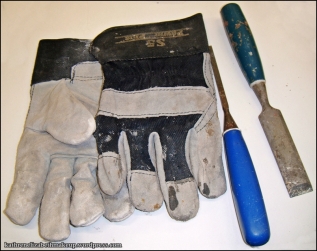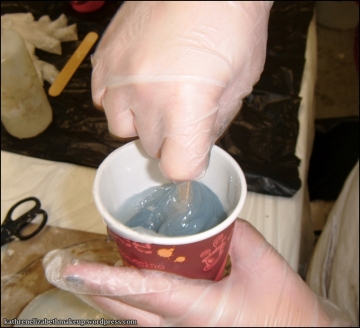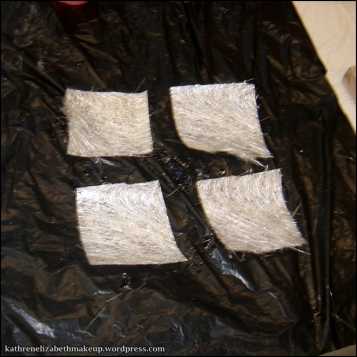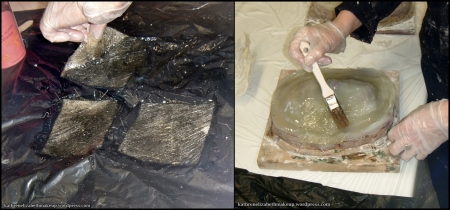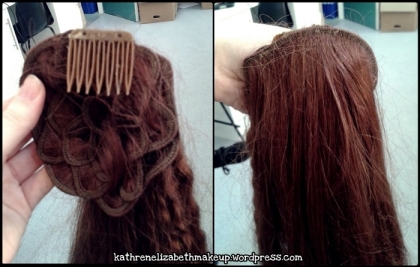Hi guys! Okay so here is the next steps taken after completing my sculpt! Hope you enjoy, if you have any questions please don’t hesitate to contact me.
So first things first. Personal Protective Equipment (PPE) – Respirator, protective clothing, plastic gloves, protective gloves, work in a well-ventilated area.
Now that the sculpt is protected with the releasing agents I was then able to start the fiberglass process. I first began by laying the moulds onto a protected surface as fibreglass is extremely messy and sticky. It is also flammable as it heats up during vulcanisation. Laying a plastic sheet down is a useful short cut as it makes it easier to clean up from surfaces.
Next I begin cutting up small squares of fibre glass tissue in preparation for the next step. I then mixed half a cup of gel coat with catalyst added to speed up the vulcanisation process. Once mixed thoroughly I was then able to apply it all over the two positives. I then waited for it to cure until it was tacky to the touch.
The next step was to apply a generous coat of laminating resin all over the cured gel coat. This would allow the fibreglass tissue to adhere to the gel coat. Whilst the laminating coat was still wet I applied one layer of tissue flattening down each strip with more laminating resin on a brush. I then left it to dry in a well-ventilated room (using the extractor fan). I did not have to cut this layer as I had made sure to lay each piece of tissue down neatly so I was able to skip this step.

Once that layer had cured I was then able to apply two layers of fiberglass matting (again using the laminating resin and leaving it to dry in between layers.)
I then left the fibre glass to solidify over night to make sure it was completely cured. The next step was to drill holes through both parts of the mould to allow washers and screws to be used as a way of closing and clamping the mould shut. This is important as the mould needs to be tightly closed to ensure the appliances edges are thin and true to the sculpted edges.
After the holes are drilled the mould can then be separated and cleaned out. I had problems with this as my mould had fused together in some parts however once the edges had been sanded down the mould was then able to be prised open using metal tools (As I was dealing with sharp metal object I made sure to wear protective gloves).
I then used a selection of wooden and metal sculpting tools to clean out the Plasterline from the mould in preparation for casting. I also use lighter fluid to further clean the mould as this dissolves the Plasterline easily.
Then the mould is ready for casting! (I unfortunately forgot to take a picture of the finished mould, But I will make sure to post one this week!)
Hopefully we will be able to run it in foam latex however due to time limitations within college is may only be made from latex which may be disappointing. Stay tuned to see the finished look after the 28th of April!
Thanks for visiting! Don’t forget, if you have any questions just leave me a comment and I will be sure to reply as soon as I can!
Katy x
Evaluation/Reflection:
As I have had quite a lot of practice with fiberglass I now feel confident enough with this process. The only troubles I had with this part of the process was the releasing of the moulds as mine had fused together as the fiberglass has overlapped when drying which was unfortunate. However, I am going to be able to solve that problem by sanding off the edges which will free the mould allowing me to open it with ease. Overall I am very happy with quality of the mould however the true test of how good the mould is will be apparent when I come to casting it in foam latex.





